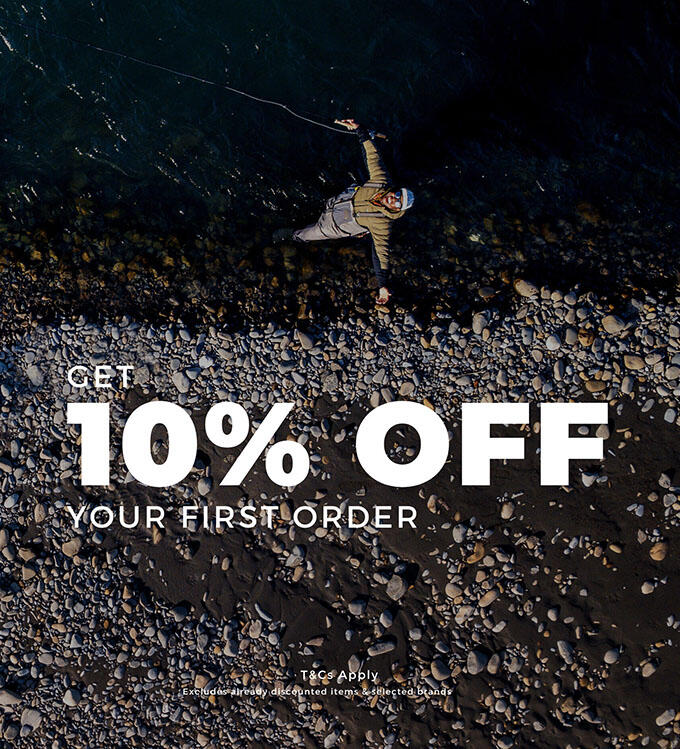The Best Stickbaits Money Can Buy
The Best Stickbaits Money Can Buy
Dive into the world of angling excellence as we explore "The Best Stickbaits Money Can Buy." In this comprehensive guide, we'll delve deep into the realm of stickbaits, those elusive lures that have anglers hooked worldwide. Discover the artistry and innovation that goes into crafting these fishing gems, and explore the top contenders that have earned their place among the best. Whether you're a seasoned angler looking to enhance your collection or a novice eager to learn more, this blog post will unveil the secrets behind stickbaits and help you make informed choices for your next fishing adventure.
Jump to where you need to be, don’t wait for us:
- What is stickbaiting and why should you give it a crack?
- The different types of stickbaits & what sets them apart
- New Zealand Stickbaits vs the rest
- Where to start if I am a beginner to stickbaiting
- Where can I buy the best stickbaits for me
Let’s crack into our run down on the best stickbaits money can buy.
What is stickbaiting and why should you give it a crack?
Stick baiting is an exhilarating and highly effective fishing technique that involves using long, slender lures, often resembling baitfish, to entice predatory fish to strike. These lures are typically designed to mimic wounded or struggling prey in the water, making them irresistible to New Zealand gamefish such as Kingfish, Tuna & Marlin. Even more popular outside New Zealand waters fisherman all over the work use stickbaits or even poppers to target Giant Trevally, Tarpon, Mahi-Mahi, Rooster Fish & many more.
Here's why stick baiting is so exciting:
- Visual Strikes: Stickbaits are designed to be fished near the surface, and when a predator attacks, it often does so explosively and visibly. Witnessing a big fish explode on a surface stickbait is a heart-pounding experience that provides an adrenaline rush like no other.
- Topwater Action: The nature of stickbaits creates enticing surface commotion, making it a topwater spectacle. There are not many forms of fishing that allow the angler to have a full visual experience whilst fishing for predatory fish. Anglers get to see the entire drama unfold, from the lure's seductive action to the thrilling moment of the strike.
- Interactive Fishing: Stick baiting requires active involvement from the angler. You control the lure's movements, twitching and pausing it to mimic the behaviour of injured prey. This hands-on approach adds an element of skill and strategy to the fishing experience. In a day and age where fishing is looked at as more of a sport this exciting form of fishing has increased engagement with many younger anglers.
- Big Fish Potential: Stickbaits have a proven track record for enticing big fish. This is due to the style of fishing occurring high in the water column. It is well known within the angling community that predatory fish transition higher in the water column when feeding. Due to this many trophy-sized fish have been caught on stickbaits, and the possibility of landing a record-breaking catch adds to the excitement.
- Easy access on land or boat: Stickbaiting is a sport that can take place landbased or offshore on a boat. Therefore making the sport accessible to anglers of all budgets. Of recent years many high-profile anglers such as Tony Wood from Moocher Hunters & Jo Edlington from J.E Wilds have showcased the success of land-based stickbaiting.
- Variety of Lures: Stickbaits come in a wide range of shapes, sizes, and colors, allowing anglers to tailor their approach to match the local baitfish and conditions. The nature of their materials makes stickbaits an affordable option for many anglers.
Overall, stick baiting combines the thrill of surface action, the art of lure manipulation, and the potential for landing trophy fish, making it an incredibly exciting and rewarding fishing technique enjoyed by anglers of all skill levels.
The different types of stickbaits & what sets them apart
This is where it gets interesting. Stickbaits are not only a fishing lure designed to catch many predatory fish but double as a collector's item for passionate and fanatical fishermen all over New Zealand. The nature of hand-crafted wooden stickbaits creates an interest in not only their fish catching prowess but their craftsmanship alike.
Handcrafted wooden stickbaits and mass-produced plastic stickbaits differ in several significant ways, including their construction, performance, and appeal to anglers. Here's a breakdown of the key differences:
1. Construction Materials:
- Wooden Stickbaits: Handcrafted wooden stickbaits are typically made from high-quality, natural wood, such as cedar, balsa, or other hardwoods. These materials offer unique buoyancy and density properties, allowing for precise control over the lure's buoyancy, action, and diving depth.
- Plastic Stickbaits: Mass-produced plastic stickbaits are molded from synthetic materials like ABS (Acrylonitrile Butadiene Styrene) or other plastics. While they can replicate the shape and colour of natural baitfish, they lack the natural buoyancy and density variations found in wood.
2. Lure Action:
- Wooden Stickbaits: Wooden stickbaits are known for their subtle and natural action. They often have a more realistic "wounded fish" movement due to their buoyancy and the way they sit on the water's surface. This lifelike action can be very appealing to fish.
- Plastic Stickbaits: Plastic stickbaits tend to have a more uniform action, which can be effective but may lack the natural nuances of wooden lures. The action of plastic stickbaits is typically designed during the molding process and may not replicate natural movements as closely.
3. Customization:
- Wooden Stickbaits: Handcrafted wooden stickbaits offer anglers the opportunity for customization. Skilled lure makers can create unique designs, paint patterns, and finishes, allowing anglers to have personalized lures tailored to specific fishing conditions or preferences.
- Plastic Stickbaits: Mass-produced plastic stickbaits are typically available in a limited range of colors and designs. While some customization is possible through paint or marker, it's not as versatile as wooden lures.
4. Durability:
- Wooden Stickbaits: Wooden stickbaits are durable but may require more care and maintenance than plastic lures. They can be prone to chipping or splitting if they collide with rocks or hard structures. For this reason it’s important to use lures from reputable lure makers such as OTL to avoid manufacturing defaults.
- Plastic Stickbaits: Plastic stickbaits are generally more robust and resistant to damage from impacts. They are often favoured for rugged fishing conditions.
5. Price:
- Wooden Stickbaits: Handcrafted wooden stickbaits are usually more expensive than their plastic counterparts due to the labor-intensive nature of their production and the quality of materials used. Often when starting out anglers will progress from plastic to wooden stickbaits as they hone their craft.
- Plastic Stickbaits: Mass-produced plastic stickbaits are typically more budget-friendly and widely available, making them accessible to a broader range of anglers.
In summary, the choice between handcrafted wooden stickbaits and mass-produced plastic stickbaits comes down to angler preference, fishing style, and the target species. Wooden stickbaits offer a more natural and customizable option but may require more care, while plastic stickbaits are readily available, durable, and suitable for a variety of fishing scenarios. Both have their merits, and experienced anglers often incorporate both types into their tackle boxes to cover a range of fishing situations.
New Zealand Stickbaits vs the rest
When it comes to stickbait manufacturers New Zealand is lucky to boast some of the best lure makers in the world. Leading the way in this regard is the incredibly respected Mike Knight who hand crafts New Zealand’s OTL Lures commonly referred to as On Top Lures. OTL lures are well represented in many topwater fishing hotsports around the world such as Oman, Hawaii, Australia & of course here in New Zealand.
New Zealand's unique environmental conditions make it an exceptional testing ground for world-class timber stickbaits, and several factors contribute to this distinction:
- Biodiversity & Terrain: New Zealand boasts a diverse range of fish species inhabiting its coastal waters. None more so than one of the worlds hardest fighting fish, the Yellowtail Kingfish. Found all around the NZ coastline these fish provide the best testers to ensure kiwi lure makers manufacture durable and high performing products.
- Variety of Habitats: New Zealand's geographical features include an array of fishing habitats, including rocky shorelines, sandy beaches, estuaries, kelp forests and reef systems. This diversity of environments offers the chance to test stickbaits in a broad spectrum of conditions
- Challenging Conditions: The country's waters can be turbulent, ranging from calm and clear to rough and turbulent, providing an excellent testing ground for stickbaits. Strong currents, tidal fluctuations, and varying water temperatures challenge the durability and effectiveness of these lures, ensuring they meet high-performance standards.
- Experienced Anglers: New Zealand boasts a community of dedicated and skilled anglers who are passionate about lure fishing. These anglers demand high-quality, effective lures and provide valuable feedback for improving stickbait designs.
- Innovative Lure Makers: New Zealand has a growing community of skilled lure makers who are continually innovating and refining their craft. These artisans push the boundaries of stickbait design, striving for excellence in performance and aesthetics. Often referred to as the Number-8 wire mentality, kiwi’s are known for getting things done and finding a way to succeed. The backbone of the NZ lure market is no different.
In summary, New Zealand's diverse ecosystems, challenging conditions, unique fish species, and perfection-minded angling community create an ideal testing ground for timber stickbaits. The continuous development and testing of lures in this environment contribute to the creation of world-class stickbaits that perform exceptionally well in various fishing scenarios globally.
Where to start if I am a beginner to stickbaiting
Choosing the right stickbait lure is crucial for a successful stickbaiting experience. Here are some steps to help you get started:
- Identify Your Target Species: Determine the fish species you intend to target. Different fish have varying feeding habits and preferences for stickbaits.
- Research Local Baitfish: Learn about the prevalent baitfish species in your fishing area. Stickbaits that resemble local baitfish are more likely to attract strikes. For example, if kingfish are feeding on local Kahawai then match your stickbait with a natural coloured lure to match.
- Understand Water Conditions: Consider the clarity and depth of the water you'll be fishing in. Clear water may require more natural and subtle colors, while murky water might benefit from brighter or more contrasting hues. Further to this point, use darker stickbaits during Dwan & Dusk while visual light is lower.
- Select the Right Size: Choose stickbaits of appropriate sizes. Smaller lures may attract Kahawai and smaller predators, while larger stickbaits are suitable for bigger Kingfish. Although this is a general rule of thumb during the early season (September-October) Kingfish are well known for engulfing smaller 50 – 75g stickbaits as they feed on smaller baitfish.
- Consider Lure Action: Think about the desired action of the stickbait. Some stickbaits are designed for a subtle, slow retrieve, while others are meant for a more aggressive, darting action. The key difference between a bibbed lure and a conventional stickbait is how aggressively you can retrieve the lure. Match the lure's action to the fish's behaviour.
- Lure Color Matters: Stickbaits come in a wide range of colours. Select colours that mimic local baitfish or match the water conditions. Bright colours like pink, chartreuse and white can be effective in attracting fish's attention. Take note that brighter colours such as pink are well known for being productive during the early parts of the season. More natural colours are known for being more consistent throughout the season.
- Floating or Sinking Lures: Although floating stickbaits out sell sinking 10 to 1 ensure that you always consider the use of a sinking stickbait. Floating stick baits are ideal for topwater action while sinking ones can be worked at various depths in the water column simply by allowing them to sink at the top of the cast prior to retrieving.
- Consider Lure Weight: Pay attention to the lure's weight. Heavier stickbaits can cast longer distances and may be necessary for windy conditions or deeper water. That being said it is important to match your lure with the correct cast weight of your rod. Always ensure that you cast within the range stipulated on your rod to ensure you maintain your warranty.
- Budget: Here's the big one. Stickbaits come in various price ranges. Set a budget that suits your needs and consider factors like durability and quality when making your choice. We all want to cast $400 plus hand-crafted lures however it’s not always a viable option. Match the hatch but don’t forget about the wallet.
- Try Different Lures: Don't be afraid to experiment with different stickbaits. Fishing conditions can change, and having a variety of lures in your tackle box allows you to adapt to different situations.
Remember that stickbaiting can be highly rewarding, but it may take some time to develop a feel for what works best in your particular fishing environment. Be patient, keep records of your successes, and don't be afraid to adapt and experiment with different stickbaits until you find the ones that consistently produce results for your target species.
Where can I buy the best stickbaits for me
In New Zealand, there are very few retailers who offer a comprehensive range of both globally recognized topwater lures and hand-crafted New Zealand Lures. At Land & Sea, we bring together the biggest global brands paired with the best New Zealand has to offer. Below is an overview of all the brands we offer both in-store and online.
- OTL Lures
- NaCl Lures
- Daiwa
- Shimano
- Nomad Design
- Rapala
- Yamashita
- Oceans Legacy
- Sluggo’s
- And many more…
Land & Sea also offers several custom releases throughout any given year. The most recent was the release of our 1st Birthday edition in collaboration with OTL Lures.
Introducing 'Old Money'. A commissioned lure seamlessly merging tradition and innovation, echoing the journey of a new business. With primary colours like dirty cream and camp green, it adorns an ocean-themed space, symbolizing growth and heritage. A visual ode to entrepreneurship and our oceans. Experience luxury and performance in one masterpiece. Featuring genuine 24-carat gold leaf and unparalleled craftsmanship of New Zealand OTL, the 100g handcrafted chop lure shines with distinction.
Keep an eye out for any & all of the world's best stickbait options at Land & Sea.










